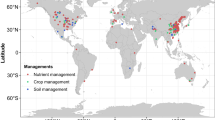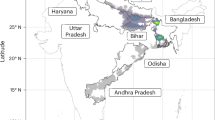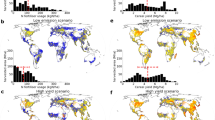Abstract
In the coming decades, a crucial challenge for humanity will be meeting future food demands without undermining further the integrity of the Earth’s environmental systems1,2,3,4,5,6. Agricultural systems are already major forces of global environmental degradation4,7, but population growth and increasing consumption of calorie- and meat-intensive diets are expected to roughly double human food demand by 2050 (ref. 3). Responding to these pressures, there is increasing focus on ‘sustainable intensification’ as a means to increase yields on underperforming landscapes while simultaneously decreasing the environmental impacts of agricultural systems2,3,4,8,9,10,11. However, it is unclear what such efforts might entail for the future of global agricultural landscapes. Here we present a global-scale assessment of intensification prospects from closing ‘yield gaps’ (differences between observed yields and those attainable in a given region), the spatial patterns of agricultural management practices and yield limitation, and the management changes that may be necessary to achieve increased yields. We find that global yield variability is heavily controlled by fertilizer use, irrigation and climate. Large production increases (45% to 70% for most crops) are possible from closing yield gaps to 100% of attainable yields, and the changes to management practices that are needed to close yield gaps vary considerably by region and current intensity. Furthermore, we find that there are large opportunities to reduce the environmental impact of agriculture by eliminating nutrient overuse, while still allowing an approximately 30% increase in production of major cereals (maize, wheat and rice). Meeting the food security and sustainability challenges of the coming decades is possible, but will require considerable changes in nutrient and water management.
This is a preview of subscription content, access via your institution
Access options
Subscription info for Japanese customers
We have a dedicated website for our Japanese customers. Please go to natureasia.com to subscribe to this journal.
Buy this article
- Purchase on SpringerLink
- Instant access to full article PDF
Prices may be subject to local taxes which are calculated during checkout





Similar content being viewed by others
Change history
10 October 2012
The two yield values in the text (2.5 and 3.6 tonnes per hectare), relating to Supplementary Fig. 4, were corrected.
References
Godfray, H. C. J. et al. Food security: the challenge of feeding 9 billion people. Science 327, 812–818 (2010)
Royal Society. Reaping the benefits. 1–86 (The Royal Society, 2009)
Tilman, D., Balzer, C., Hill, J. & Befort, B. L. Global food demand and the sustainable intensification of agriculture. Proc. Natl Acad. Sci. USA 108, 20260–20264 (2011)
Foley, J. A. et al. Solutions for a cultivated planet. Nature 478, 337–342 (2011)
Robertson, G. P. & Swinton, S. M. Reconciling agricultural productivity and environmental integrity: a grand challenge for agriculture. Front. Ecol. Environ 3, 38–46 (2005)
Cassman, K. G., Dobermann, A., Walters, D. T. & Yang, H. Meeting cereal demand while protecting natural resources and improving environmental quality. Annu. Rev. Environ. Resour. 28, 315–358 (2003)
Foley, J. A. et al. Global consequences of land use. Science 309, 570–574 (2005)
Cassman, K. G. Ecological intensification of cereal production systems: Yield potential, soil quality, and precision agriculture. Proc. Natl Acad. Sci. USA 96, 5952–5959 (1999)
Matson, P. A. & Vitousek, P. M. Agricultural intensification: Will land spared from farming be land spared for nature? Conserv. Biol. 20, 709–710 (2006)
Clough, Y. et al. Combining high biodiversity with high yields in tropical agroforests. Proc. Natl Acad. Sci. USA 1–6 (2011)
Burney, J. A., Davis, S. J. & Lobell, D. B. Greenhouse gas mitigation by agricultural intensification. Proc. Natl Acad. Sci. USA 107, 12052–12057 (2010)
Monfreda, C., Ramankutty, N. & Foley, J. A. Farming the planet: 2. Geographic distribution of crop areas, yields, physiological types, and net primary production in the year 2000. Glob. Biogeochem. Cycles 22, GB1022 (2008)
Lobell, D. B., Cassman, K. G. & Field, C. B. Crop yield gaps: their importance, magnitudes, and causes. Annu. Rev. Environ. Resour. 34, 179–204 (2009)
Portmann, F. T., Siebert, S. & Doell, P. MIRCA2000—global monthly irrigated and rainfed crop areas around the year 2000: a new high-resolution data set for agricultural and hydrological modeling. Glob. Biogeochem. Cycles 24, GB1011 (2010)
Ju, X.-T. et al. Reducing environmental risk by improving N management in intensive Chinese agricultural systems. Proc. Natl Acad. Sci. USA 106, 3041–3046 (2009)
Liu, J. et al. A high-resolution assessment on global nitrogen flows in cropland. Proc. Natl Acad. Sci. USA 107, 8035–8040 (2010)
MacDonald, G. K., Bennett, E. M., Potter, P. A. & Ramankutty, N. Agronomic phosphorus imbalances across the world's croplands. 108, 3086–3091 (2011)
Vitousek, P. M. et al. Agriculture. Nutrient imbalances in agricultural development. Science 324, 1519–1520 (2009)
Oenema, O. & Pietrzak, S. Nutrient management in food production: Achieving agronomic and environmental targets. Ambio 31, 159–168 (2002)
Cassman, K. G., Dobermann, A. & Walters, D. T. Agroecosystems, nitrogen-use efficiency, and nitrogen management. Ambio 31, 132–140 (2002)
Jordan, N. et al. Sustainable development of the agricultural bio-economy. Science 316, 1570–1571 (2007)
Sánchez, P. A. Tripling crop yields in tropical Africa. Nature Geosci. 3, 299–300 (2010)
Lambin, E. F. et al. The causes of land-use and land-cover change: moving beyond the myths. Glob. Environ. Change 11, 261–269 (2001)
Parry, M., Canziani, O. & Palutikof, J. &. co-authors Technical Summary. Climate Change 2007: Impacts, Adaptation and Vulnerability. Contribution of Working Group II to the Fourth Assessment Report of the Intergovernmental Panel on Climate Change (eds Parry, M. L., Canziani, O. F., Palutikof, J. P., van der Linden, P. J. and Hanson, C. E. ) 23–78 (Cambridge Univ. Press, 2007)
Lobell, D. B., Schlenker, W. & Costa-Roberts, J. Climate trends and global crop production since 1980. Science 333, 616–620 (2011)
Howden, S. M. et al. Adapting agriculture to climate change. Proc. Natl Acad. Sci. USA 104, 19691–19696 (2007)
Licker, R. et al. Mind the gap: how do climate and agricultural management explain the “yield gap” of croplands around the world? Glob. Ecol. Biogeogr. 19, 769–782 (2010)
Johnston, M. et al. Closing the gap: global potential for increasing biofuel production through agricultural intensification. Environ. Res. Lett. 6, 034028 (2011)
Ramankutty, N., Evan, A. T., Monfreda, C. & Foley, J. A. Farming the planet: 1. Geographic distribution of global agricultural lands in the year 2000. Glob. Biogeochem. Cycles 22, GB1003 (2008)
Acknowledgements
We thank G. Allez and K. Milligan for assistance with data collection. We are grateful to R. Licker, G. MacDonald, M. Mueller, S. Polasky, P. Potter, P. Reich, L. Schulte-Moore, D. Tilman, J. Van Wart and the Foley Laboratory for helpful conversations. We thank P. Robertson and P. Smith for helpful comments on the manuscript. Funding was provided by a National Science Foundation Graduate Research Fellowship and a University of Minnesota College of Food, Agricultural and Natural Resource Sciences Fellowship to N.D.M., a Natural Sciences and Engineering Research Council (NSERC) of Canada Discovery Grant to N.R., Gordon and Betty Moore Foundation funding to J.A.F., and support from the University of Minnesota Institute on the Environment.
Author information
Authors and Affiliations
Contributions
N.D.M. led the study design, data analysis and writing. J.S.G. contributed substantially to the yield-gap data analysis and writing. D.K.R. and M.J. assisted with data analysis and writing. J.A.F. and N.R. assisted with study design and writing.
Corresponding author
Ethics declarations
Competing interests
The authors declare no competing financial interests.
Supplementary information
Supplementary Information
This file contains Supplementary Methods, a Supplementary Discussion, Supplementary Figures 1-8, Supplementary Tables 1-3 and additional references. (PDF 11632 kb)
Supplementary Data
This file contains estimates of intensification prospects through closing yield gaps by crop, country, and region.This file was replaced online on 15 November 2013 to correct a slight discrepancy in the area calculations. (XLS 746 kb)
Rights and permissions
About this article
Cite this article
Mueller, N., Gerber, J., Johnston, M. et al. Closing yield gaps through nutrient and water management. Nature 490, 254–257 (2012). https://doi.org/10.1038/nature11420
Received:
Accepted:
Published:
Issue Date:
DOI: https://doi.org/10.1038/nature11420
This article is cited by
-
Irrigation expansion has kept pace with the CO2 fertilization effect on vegetation growth in a typical arid region
Environmental Sciences Europe (2024)
-
Phosphorus applications adjusted to optimal crop yields can help sustain global phosphorus reserves
Nature Food (2024)
-
Co-benefits for net carbon emissions and rice yields through improved management of organic nitrogen and water
Nature Food (2024)
-
Indian interstate trade exacerbates nutrient pollution in food production hubs
Communications Earth & Environment (2024)
-
Half of twenty-first century global irrigation expansion has been in water-stressed regions
Nature Water (2024)



